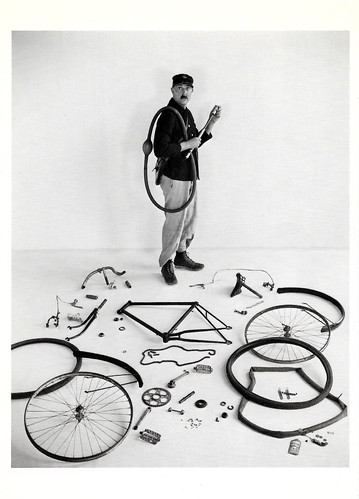
American postcard by Fotofolio, New York, NY, no. RD7. Photo: Robert Doisneau, 1949.
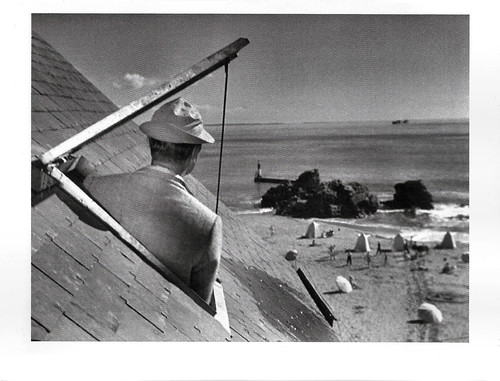
French postcard by Les Films de Mon Oncle, Paris. Photo: Collection Le Cinémathèque Française. Jacques Tati in Les Vacances de Monsieur Hulot/Mr. Hulot's Holiday (Jacques Tati, 1953).

French postcard by Les Films de Mon Oncle, Paris. Jacques Tati in Playtime (Jacques Tati, 1967).
A peaceful village that does not escape modernity
Jacques Tati was born Jacques Tatischeff in 1907 in Le Pecq, 19 km west of the centre of Paris. He was the son of a Dutch mother and the Russian military attaché at the Russian embassy in Paris. At 18, he entered military service and from the age of 20, he was active as a professional rugby player. Later, he made a living as a pantomime player.
He was in variety theatre, where he performed several comic mime acts. Here he learnt the art of the comic movement and gained inspiration for his later films. His comic acts, based on various sports, were a success in the theatre. He made his screen debut in a series of short featurettes, tailored to show off his practised gags, notably Oscar, champion de tennis/Oscar, tennis champion (Jack Forrester, 1932) and Soigne ton gauche/Watch Your Left (René Clément, 1936), a very funny boxing sketch.
The Second World War, military service and inherent strictures resulting from the German occupation put a temporary halt to his career. Then, in 1946, through a friend, the writer-director Claude Autant-Lara, Jacques obtained a small role in the whimsical fantasy Sylvie et le fantôme/Sylvie and the Ghost (Claude Autant-Lara, 1946), about a girl (Odette Joyeux) in love with a ghost (Tati).
The small township of Sainte-Sévère, where Tati had taken refuge during the occupation, served as inspiration for his first film, the short L'école des facteurs/School for Postmen (Jacques Tati, 1947), in which Tati plays the character of François, a bumbling hyperactive postman. The film was so successful that Tati was offered the chance to make his first feature-length film, starring that same character.
Jour de fête (Jacques Tati, 1949) shows a postman in a rural village, Sainte-Sévère-sur-Indre, which is isolated and deprived compared to the rest of the modern world. But even the peaceful village does not escape modernity: on the day of the French national holiday on 14 July, a film is shown for the first time, and it is about the efficiency of the US postal service. In this film, postman François (played by Tati himself) sees how his colleagues in the United States deliver their mail by car and even by plane. François does everything by bike and now decides to drive his bike as fast as a car. The result is a whole series of stunts, which Tati himself performed on the bicycle. Jour de fête became a huge international success.
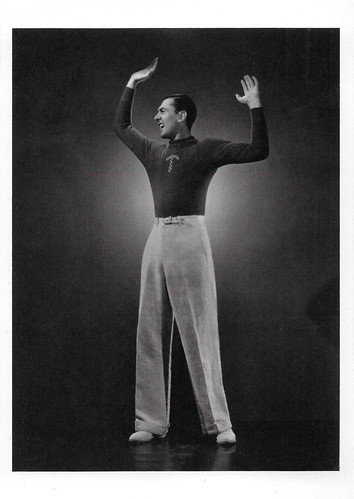
French postcard by Les Films de Mon Oncle. Photo: Collection La Cinémathèque Française. Jacques Tati in 'Impressions sportives' (1935).
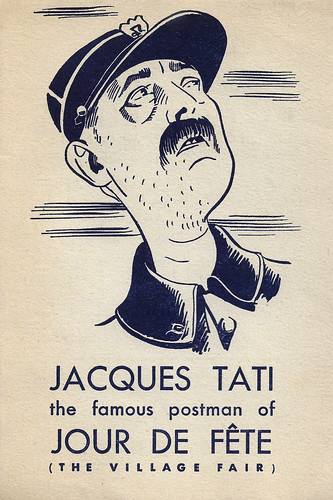
French postcard by Cinéma de L'Avenue, Paris. Image: Jacques Tati in Jour de Fête/The Village Fair (Jacques Tati, 1949). Caption: Three things to see during your stay in Paris. La Tour Eiffel, Le Chateau de Versailles and Jour de fête / The Village Fair with Jacques Tati. The greatest French comedian since Max Linder and Chaplin. English subtitles. Now playing at Cinéma de L'Avenue, 5, Rue du Colisée, Champs Élysees corner.

French postcard by Les Films de Mon Oncle. Photo: Collection Le Cinémathèque Française. Jacques Tati in Les Vacances de Monsieur Hulot/Mr. Hulot's Holiday (Jacques Tati, 1953).
An ungainly, yet hilarious figure
Jacques Tati then made the classic Les Vacances de Monsieur Hulot (Jacques Tati, 1953). In this film, Tati played the character of Monsieur Hulot for the first time. Tati took the name of the character from the architect Hulot who lived in the same apartment building as himself. Hulot arrives in a rickety 1924 Amilcar. I.S. Mowis at IMDb: "Tall and reedy, clad in a poplin coat, wearing a crumpled hat, striped socks, trousers which are patently too short, rolled umbrella, a pipe firmly clenched between his teeth and perambulating with an odd stiff-legged gait, Hulot cuts an ungainly, yet hilarious figure. Well-meaning though he is, he invariably leaves disaster in his wake and departs the scene quickly as things go wrong, letting others sort out the mess."
Monsieur Hulot would become one of the icons of comic cinematography. Style features of Tati are silent, small jokes hidden in a scene. These scenes are almost always filmed in total shots, keeping the camera and thus the audience at a distance. This makes the films like observations of people's behaviour. Tati shows the viewer an absurd, satirical mirror in which the viewer can recognise his own behaviour, from everyday life.
Another feature that made Tati differ from other slapstick actors was his use of sound. In Tati's films, the sound is as important as the image; many strange sound effects, such as footsteps, creaking and squeaking doors and clinking glass, enhance the effect of the jokes. In 1958, Tati made Mon Oncle (Jacques Tati, 1958), a comedy that was awarded the Oscar for best foreign film. This film also sees Tati as Monsieur Hulot. Tati criticises today's modern society in the film.
According to Tati, technology, decadence and greed started playing an increasing role in our society. Real human values such as individuality, sociability, helpfulness and exercise are lost as a result. Crowds are central to all of Tati's films, but there is always a character who refuses to adapt, but eventually dissolves into the masses.
This individual, played by Tati himself, fights (often unconsciously) against modernity. He understands nothing about machines and this often results in hilarious failures, in which modern technology is destroyed by human nature. The film juxtaposes the good old days with modern technology. Nostalgia clashes with the unimaginative, decadent, massive and impersonal world of modern times.

French postcard by Les Films de Mon Oncle. Photo: Collection La Cinémathèque Française. Jacques Tati in Les Vacances de Monsieur Hulot/Monsieur Hulot's Holiday (Jacques Tati, 1953).

French postcard, no. C97. Jacques Tati in Mon Oncle/My Uncle (Jacques Tati, 1958).
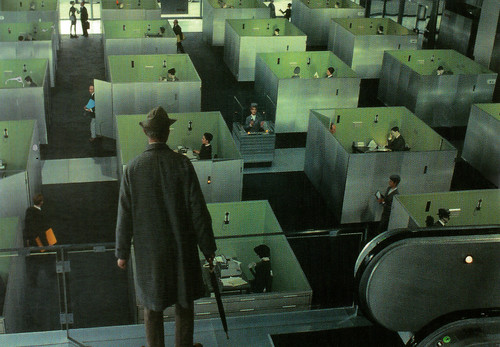
French postcard by Les Films de Mon Oncle, Paris. Jacques Tati in Playtime (Jacques Tati, 1967).
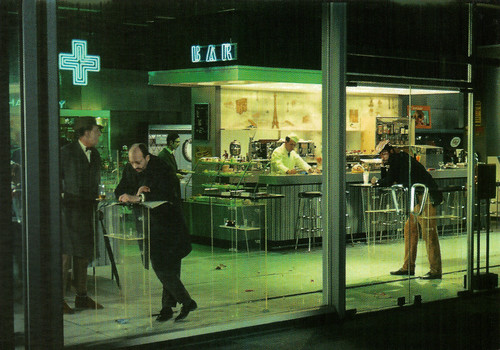
French postcard by Les Films de Mon Oncle, Paris. Jacques Tati in Playtime (Jacques Tati, 1967).
A Sci-Fi comedy in which the world was completely turned into a very large city
Jacques Tati then started working on an extremely expensive film, Playtime (Jacques Tati, 1967), a kind of Sci-Fi comedy in which the world was completely turned into a very large city. Lacking suitable filming locations, Tati had an entire full-scale futuristic city (Tativille) recreated in Joinville-le-Pont. The shooting took almost four years. It was shot in the expensive 70 mm format and the most extraordinary filming techniques were used. Tati experimented with colour and used a very recognisable soundtrack in his films, which is repeated again and again throughout the film.
When Playtime was released in 1967, critics' reactions were divided. In France, the film was reasonably successful, but nothing came of the intended American success: the film was not even released there. The picture's total budget had been $3 million and left Tati bankrupt. Tati was now unemployed: no one wanted to invest money in his films.
Only in 1972 did he return to the big screen, in the film Trafic (Jacques Tati, 1972), a satire of modern man's love of cars, partly shot in the Netherlands and co-directed by Dutch cinematographer Bert Haanstra. This film was not a success either. Tati then made the television film Parade (Jacques Tati, 1974), a comedy about circus life, for Swedish television. Creditors impounded Tati's films, which were not re-released until 1977 when a canny Parisian distributor expunged his outstanding debts.
Jacques Tati died of cancer in 1982 in Paris at the age of 75. Since 1944, he had been married to Micheline Winter with whom he had two children.
In 2010, L'Illusionniste was released, a full-length animated film by Sylvain Chomet, based on a script by Tati. The main character in this film, an old, disillusioned magician named Tatischeff, is a cartoon version of Monsieur Hulot. The idea to release Tati's script as a cartoon came from Tati's daughter who did not want another actor to imitate her father. In the film, the protagonist walks into a cinema where Mon Oncle is currently being played. The film is not so much comic as melodramatic and builds on Tati's ideas about alienation and the demise of old trades.

French postcard by La sociètè des Amis de la Bibliothèque Forney, Paris, Série J. Jacquelin, no. 5. Original poster design: Jean Jacquelin. Collection: Marc Savy. Film poster for Jour de fête/The Big Day (Jacques Tati, 1949).
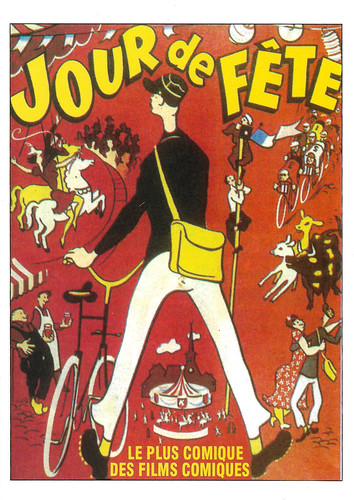
French postcard in the Encyclopédie du Cinéma series by Carterie Artistique et Cinématographique, Pont du Casse, no. EDC 394. Poster design: Film poster for Jour de fête/The Big Day (Jacques Tati, 1949). Caption: The funniest of all comedy films.

Swiss postcard by CVB Publishers / News Productions, no. 57212. Collection: Cinémathèque Suisse, Lausanne. Design poster: Lengren for CWF. Polish film poster for Les Vacances de Monsieur Hulot/Mr. Hulot's Holiday (Jacques Tati, 1953).
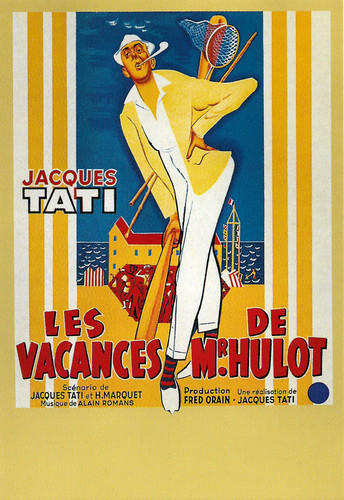
French postcard by Editions Zreik, Paris, in the Collection Télérama, La mémoire du cinéma, no. 170. Film poster for Les Vacances de Monsieur Hulot/Mr. Hulot's Holiday (Jacques Tati, 1953).

French postcard by Editions Ramsay, no. 170. Image: Pierre Étaix / Gaumont. Film poster for Mon Oncle/My Uncle (Jacques Tati, 1958).
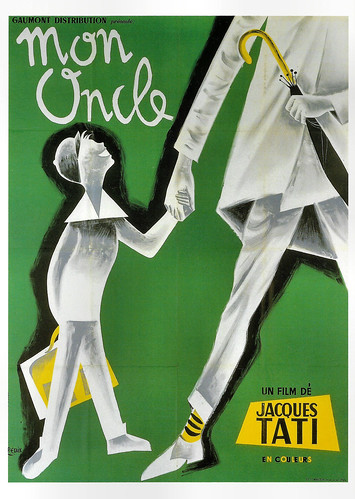
Swiss postcard by CVB Publishers, no. 57383. Collection Cinématèque Suisse, Lausanne. Film poster for Monb Oncle (Jacques Tati, 1958).
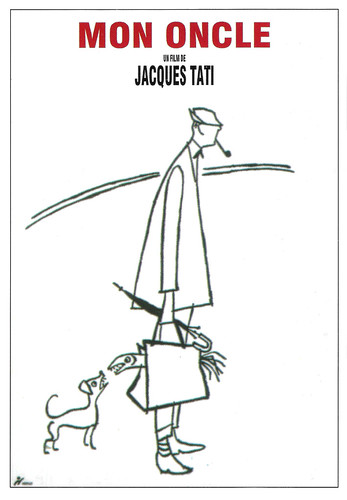
French postcard in the Encyclopédie du Cinéma series by Carterie Artistique et Cinématographique, Pont du Casse, no. EDC 395. Film poster for Mon Oncle (Jacques Tati, 1958).

French postcard by CVB Publishers, no. 57383, Collection Cinémathèque Suisse Lausanne. Jacques Tati in Trafic (Jacques Tati, 1971).
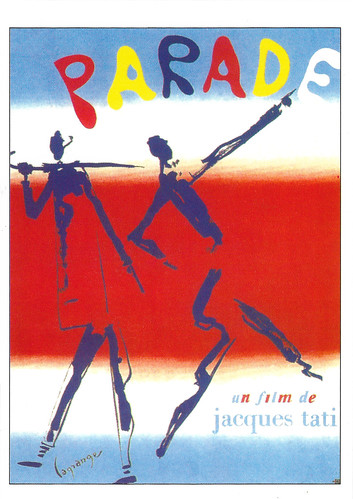
French postcard in the Encyclopédie du Cinéma series by Carterie Artistique et Cinématographique, Pont du Casse, no. EDC 392. Poster design: Lagrange. Film poster for Parade (Jacques Tati, 1974).
Sources: Wikipedia (Dutch) and IMDb.
No comments:
Post a Comment